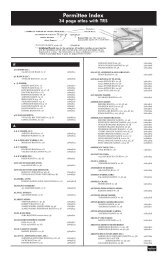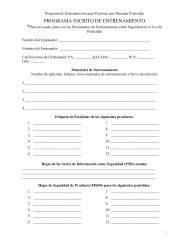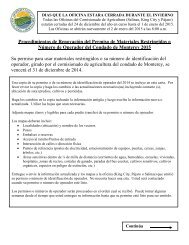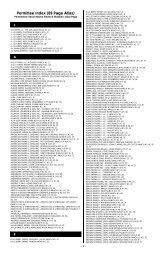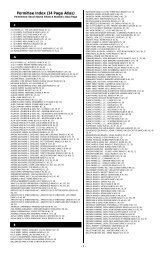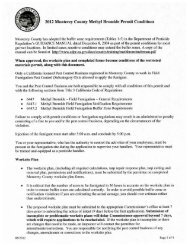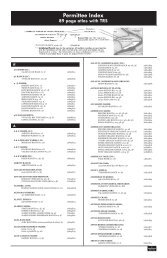Crop Report - Monterey County Agriculture Commissioner's Office
Crop Report - Monterey County Agriculture Commissioner's Office
Crop Report - Monterey County Agriculture Commissioner's Office
You also want an ePaper? Increase the reach of your titles
YUMPU automatically turns print PDFs into web optimized ePapers that Google loves.
Vegetable <strong>Crop</strong>s<br />
CROP 1 YEAR ACREAGE<br />
PRODUCTION PER<br />
ACRE<br />
TOTAL<br />
UNIT<br />
VALUE PER<br />
UNIT<br />
TOTAL 2<br />
Anise<br />
2011<br />
2010<br />
610<br />
602<br />
19.53<br />
20.00<br />
11,900<br />
12,000<br />
ton<br />
ton<br />
$787.80<br />
$664.73<br />
$9,375,000<br />
$7,977,000<br />
Artichokes<br />
2011<br />
2010<br />
4,992<br />
4,959<br />
7.19<br />
7.03<br />
35,900<br />
34,900<br />
ton<br />
ton<br />
$1,374.13<br />
$1,370.44<br />
$49,331,000<br />
$47,828,000<br />
Asparagus<br />
2011<br />
2010<br />
1,850<br />
2,297<br />
4.18<br />
4.20<br />
7,740<br />
9,650<br />
ton<br />
ton<br />
$1,761.18<br />
$1,600.87<br />
$13,632,000<br />
$15,448,000<br />
Bok Choy<br />
2011<br />
2010<br />
491<br />
393<br />
22.09<br />
23.81<br />
10,900<br />
9,360<br />
ton<br />
ton<br />
$257.46<br />
$223.73<br />
$2,806,000<br />
$2,094,000<br />
Broccoli, Bulk 3<br />
2011<br />
2010<br />
N/A<br />
N/A<br />
N/A<br />
N/A<br />
121,000<br />
122,000<br />
ton<br />
ton<br />
$534.98<br />
$549.08<br />
$64,733,000<br />
$66,988,000<br />
Fresh<br />
2011<br />
2010<br />
50,506<br />
49,926<br />
7.31<br />
7.21<br />
369,000<br />
360,000<br />
ton<br />
ton<br />
$630.26<br />
$639.27<br />
$232,566,000<br />
$230,137,000<br />
Broccoli, Total<br />
2011<br />
2010<br />
52,694<br />
60,926<br />
N/A<br />
N/A<br />
N/A<br />
N/A<br />
N/A<br />
N/A<br />
N/A<br />
N/A<br />
$297,299,000<br />
$297,125,000<br />
Cabbage, Bulk<br />
2011<br />
2010<br />
N/A<br />
N/A<br />
N/A<br />
N/A<br />
38,200<br />
37,400<br />
ton<br />
ton<br />
$307.47<br />
$308.72<br />
$11,745,000<br />
$11,546,000<br />
Fresh<br />
2011<br />
2010<br />
3,420<br />
3,251<br />
20.48<br />
19.89<br />
70,100<br />
64,700<br />
ton<br />
ton<br />
$341.88<br />
$342.49<br />
$23,966,000<br />
$22,159,000<br />
Cabbage, Total<br />
2011<br />
2010<br />
4,925<br />
5,131<br />
N/A<br />
N/A<br />
N/A<br />
N/A<br />
N/A<br />
N/A<br />
N/A<br />
N/A<br />
$35,711,000<br />
$33,705,000<br />
SPOTLIGHT ON<br />
Vacuum/Hydro-Vacuum Packing<br />
• Vacuum cooling technology for fresh produce was developed with agricultural industry<br />
financing, in a location off of Highway 183 between Salinas and Castroville. The first commercial<br />
use of vacuum cooling was in Salinas in 1948 for iceberg lettuce.<br />
• Vacuum cooling technologies, also known as precooling product prior to cold storage, are used<br />
throughout the world for fresh fruits and vegetables, maintaining product quality by completing<br />
an effective “cold chain.” Vacuum cooling entails placing product in a cooling chamber typically<br />
on pallets, and then removing the air from the chamber using a vacuum pump. As the product<br />
reaches its flashpoint a sudden surface water vaporization results, producing a localized cooling<br />
effect due to the energy required to make the transition from liquid to vapor H 2<br />
O.<br />
• Hydrovacuum cooling, where water is sprayed on the product just before the flashpoint of the<br />
vacuum cycle, is used to prevent low moisture content product such a leaf lettuce and celery<br />
from drying out.<br />
• Vacuum cooling technology is one of the most energy efficient cooling methods available and<br />
cools 2-3 times faster than forced air cooling.<br />
1<br />
Organic figures included in totals<br />
2<br />
Totals may not calculate due to rounding<br />
3<br />
“Bulk” may include one or more of the following:<br />
“Food Service” commodities are destined to be sold to restaurants and food service companies for the preparation of meals eaten away from home, and are sold in larger<br />
packages; “Processing” commodities are destined to be processed in a way that substantially alters the raw nature of the product such as freezing, drying, or cooking, and<br />
does not necessarily include processes such as washing, slicing, or chopping; and “Value Added” commodities are destined to be sold to consumers to prepare meals at<br />
home, and are sold in smaller packages with consumer labeling. Figures do not include additional cost of packaging or washing, slicing, chopping, mixing, etc.<br />
ag.co.monterey.ca.us | 2011 <strong>Monterey</strong> <strong>County</strong> <strong>Crop</strong> <strong>Report</strong> | 7



